

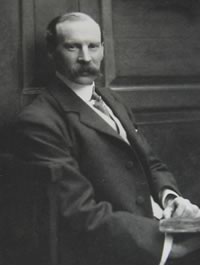 by Tony
Wrenn
by Tony
Wrenn
The AIA, born on February 23, would be 50 in 1907, and there would
be a party. The engraved invitations read “The American
Institute of Architects, founded in the year 1857, will commemorate
the Fiftieth Anniversary of this date, in the City of Washington,
on the eighth of January 1907, and will esteem it an honor if the
_______can be represented on this occasion.” To confuse one a
bit, the actual “commemorative exercises” were on January
9, beginning at the New Willard Hotel at 14th and Pennsylvania at
2:30 p.m., with greetings from architecture societies, art groups,
and universities around the world, and featured “addresses,
reminiscent and historical.”
The festivities concluded at the Octagon at 4:30 p.m., with a
reception and tea prepared by “patronesses” who were the
wives of members, or, in the case of AIA President Robert S.
Peabody, his daughter, Miss Peabody. An exhibition of the works of
Sir Aston Webb, who had the night before received the AIA’s
first Gold Medal, was on view, and Webb was present to talk with
birthday celebrants. During the evening, President Peabody unveiled
a bronze tablet “in honor of its founders and of those who
joined with them to Frame its Constitution and By-Laws.” There
were 13 names on the list of founders; 18 on the list of those who
joined with them. The birthday dinner followed “on the 10th
floor, New Willard, at 7:30 p.m.”
An early commemoration
Glenn Brown, the AIA secretary and treasurer, had penned a short
history of the AIA’s first 50 years in which he described
“noted” conventions and events and praised those who had
served as president. There had been but 10 presidents in those 50
years. He noted especially the successes of the Institute “in
the past seven years,” 1899–1907. “It initiated the
movement for systematic improvement of cities in this country;
secured the appointment of a Park Commission to report on the
development of Washington City; prevented the remodeling of the
White House and extension of the Capitol on lines which would have
destroyed their beauty; preserved the Mall, by demonstrating that
an improper location of the Agricultural Building would destroy the
future artistic development of the city . . . aided in the
establishment of the American Academy in Rome, a post-graduate
school in architecture painting, sculpture and music. . . gave in
1907 its first Gold Medal for distinguished merit in Architecture.
. . thus establishing a precedent which will be followed of
honoring those who have distinguished themselves in our
Art.”
 Indeed, the
Gold Medal was the first award approved by the AIA, and it, and the
School Medal, authorized in 1914 and designed by Victor D. Brenner,
have stood the test of time, for both are still awarded.
Indeed, the
Gold Medal was the first award approved by the AIA, and it, and the
School Medal, authorized in 1914 and designed by Victor D. Brenner,
have stood the test of time, for both are still awarded.
The Royal Institute of British Architects (RIBA) had given its Gold
Medal both to AIA members Richard Morris Hunt and Charles F. McKim.
McKim, anxious to return the favor, suggested an AIA Gold Medal,
with Sir Aston Webb as the recipient. Webb had been president of
RIBA, and it was he who had awarded the medal to McKim in London.
The American Gold would be the highest honor the Institute could
award an architect.
The design of an American Gold Medal was given to sculptor Adolph
A. Weinman, whose work on the Wisconsin State Capitol and
Pennsylvania Station in New York, among others, was internationally
known. His design featured, on the obverse, the profiles of
Polygnotus, Ictinus, and Phidias, the architects and chief sculptor
of the Parthenon, and their tools: a brush, a sculptor’s
modeling tool, a compass, and a triangle. On the reverse an eagle
with upraised wings as if just landed or ready to fly away, plucks
a laurel branch from a rock. “AIA” and “A.A.
Weinman, M.C.M.VII.” are etched into the rock. The
recipient’s name, and the date awarded would, as is still the
custom, be engraved on the rim.
The 1907 and first such medal was awarded to Webb at a reception in
the Corcoran Gallery of Art on the evening of January 8. Since the
RIBA medal was awarded by the Crown, McKim initially suggested that
the AIA medal be awarded by the American president, but that idea
was vetoed by Theodore Roosevelt. He did not rule out his
participation in the award though, and, during Webb’s stay in
Washington, invited Webb to lunch at the White House.
In the Gold Medal presentation to Webb, AIA President Frank Miles
Day noted: “Matthew Arnold’s dictum that not only is good
work needed to put a poet in secure place, but a great body of good
work, is no less true of other arts than it is of poetry. On the
score of amplitude, your achievement lacks nothing, for no
architect in England, save Sir Christopher himself, has been
entrusted with the conduct of so many and such vast
works.”
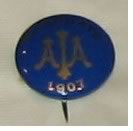 Webb
responded, “I have come over here personally to say
‘Thank you’ in the sincerest and the directest and the
simplest way I can. And to assure you that all architects on the
other side of the water will deeply appreciate the fact that on
this, the jubilee day of your Institute, and the institution of
this gold medal, you should send it over to the other side ... It
has always been one of my happiest recollections that it fell to my
lot to have the privilege to hand our medal to Mr. McKim.
(Applause) He came over personally to receive it, and I need hardly
tell you that directly he arrived he entered into our hearts and
affections and has remained there ever since.
(Applause).”
Webb
responded, “I have come over here personally to say
‘Thank you’ in the sincerest and the directest and the
simplest way I can. And to assure you that all architects on the
other side of the water will deeply appreciate the fact that on
this, the jubilee day of your Institute, and the institution of
this gold medal, you should send it over to the other side ... It
has always been one of my happiest recollections that it fell to my
lot to have the privilege to hand our medal to Mr. McKim.
(Applause) He came over personally to receive it, and I need hardly
tell you that directly he arrived he entered into our hearts and
affections and has remained there ever since.
(Applause).”
Later, Webb would win the hearts of the Americans when, in
responding to a toast, he said “As we are all making
architectural similes tonight, I compare myself, and have done so
all the evening, to a little house in New York surrounded by
skyscrapers. I hope these gentlemen will not mind this comparison,
but, of course, in speaking of skyscrapers, I refer only to the
good ones.”
Roosevelt assists in a grand
exposition
There would be another convention in 1907, the 41st, held in
November, in which Day suggested, “It is in the service of the
people and not of its own members that the Institute finds, and
will find, its widest and best field. It is by unconsciously
stimulating in its members a desire and ability to be of public
service that it will find its greatest usefulness.” Noting
that there was opposition to location of the Grant Memorial at the
foot of the West Front of the Capitol on the Mall, the AIA
reiterated its firm support for that location, as suggested by the
Park Commission Plan, and proposed a memorial to artist and
sculptor Augustus Saint-Gaudens who, in 1907, had “died as one
of the acknowledged masters of his time.”
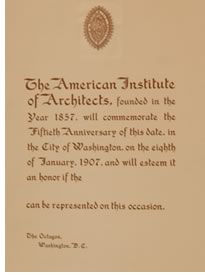 After approval
of the undertaking, AIA President Gilbert and Secretary Brown
undertook the planning of the memorial meeting. Mrs. Saint-Gaudens
participation was secured, space at the Corcoran Gallery was set
aside, and Brown and Gilbert began collecting Saint-Gaudens’
works for the exhibition.
After approval
of the undertaking, AIA President Gilbert and Secretary Brown
undertook the planning of the memorial meeting. Mrs. Saint-Gaudens
participation was secured, space at the Corcoran Gallery was set
aside, and Brown and Gilbert began collecting Saint-Gaudens’
works for the exhibition.
The pieces, from the Saint-Gaudens studio, loaned from museums,
institutions, and private collections, were carefully installed by
Brown and his coworkers, often working late into the night. One
piece that Brown felt was important for the exhibition was a bust
of General Sherman, which was at West Point, but West Point would
not part with it. Brown appealed to President Theodore Roosevelt,
who told his secretary to direct West Point to send the bust.
“A few days before the exhibition opened, Roosevelt and Mrs.
Roosevelt came into the gallery, inspecting the pieces of sculpture
that were in place. Seeing me [Brown] he said: ‘Have you
gotten the bust of General Sherman?’ I replied, ‘No, Mr.
President, I’ve not even heard that we could get it.’
Roosevelt walked toward the office. In a few minutes Mrs. Roosevelt
came back and said ‘The President wants to see you.’ I
followed her back to the office where we found the President. He
then dictated the following telegram: ‘Col. Scott, see to it
personally that the Bust of General Sherman is at the Corcoran
Gallery within twenty-four hours.’ ‘That will bring
it,’ said Theodore Roosevelt, bringing his fist down with a
bang upon the desk. It was delivered at the Corcoran Gallery within
twenty-four hours, brought by a special messenger.”
In the atrium at the Corcoran, Saint-Gaudens’ Victory-Peace,
“laurel crowned, right arm extended and holding in her left
hand an olive branch,” was placed on the landing of the great
marble stair. “She appeared to move forward gracefully,”
Brown wrote, “as she welcomed the guest[s].” A
speaker’s stand, in keeping with the style of the hall, was
erected in front of Victory-Peace. There, on December 15, 1908, at
9 p.m. before 156 of Saint-Gaudens’ works, the AIA paid its
tribute.
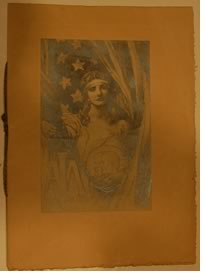 Roosevelt
spoke: “He worked among his own people, and his work was of
his own time; but yet it was of all time, for in his subjects he
ever seized and portrayed that which was undying.”
Roosevelt
spoke: “He worked among his own people, and his work was of
his own time; but yet it was of all time, for in his subjects he
ever seized and portrayed that which was undying.”
Roosevelt praised the coinage Saint-Gaudens had designed for the
United States: “I believe, more beautiful than any coins since
the days of the Greeks,” and of art in America. “In any
nation those citizens who possess the pride in their nationality,
without which they cannot claim to be good citizens, must feel a
particular satisfaction in the deeds of every man who adds to the
sum of worthy national achievement . . . Particularly should this
be so with us in America. As is natural we have won our successes
in the field of an abounding material achievements; we have
conquered a continent; we have laced it with railways, we have
dotted it with cities. Quite unconsciously, and as a mere incident
to this industrial growth, we have produced some really marvelous
artistic effects. Take for instance, the sight offered the man who
travels on the railroad from Pittsburgh through the line of iron
and steel towns which stretch along the Monongahela. I shall never
forget a journey I thus made a year or so ago. The morning was
misty, with showers of rain. The flames from the pipes and doors of
the blast furnaces flickered red through the haze. The huge
chimneys and machinery were of strange and monstrous shapes. From
the funnels the smoke came saffron, orange, green, and blue, like a
landscape of Turner. What a chance for an artist of real genius!
Again, some day people will realize that one effect of the
‘skyscrapers’ of New York, of the massing of buildings of
enormous size and height on an island surrounded by waterways, has
been to produce a city of singularly imposing type and of
unexampled picturesqueness. A great artist will yet arise to bring
before our eyes that powerful irregular skyline of the great city
at sunset, or in the noonday brightness, and, above all, at night,
when the lights flash from the dark mountainous mass of buildings,
from the stately bridges that span the East River, and from the
myriad craft that blaze as they ply to and fro across the
waters.”
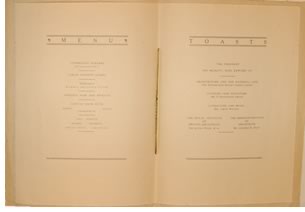 And of
Saint-Gaudens and his statue of Lincoln: “We look . . .
stirred to awe and wonder and devotion for the great man who, in
strength and sorrow, bore the people’s burdens through the
four years of our direst need, and then, standing as a high priest
between the horns of the altar, poured out his lifeblood for the
nation whose life he had saved. In this quality of showing the
soul, Saint-Gaudens’ figures are more impressive than the most
beautiful figures that have come down from the art of ancient
Greece; for their unequaled beauty is of form merely, and
Saint-Gaudens’ is of the spirit within.” The guests, an
astounding number near 2,000, were, Brown noted “an imposing
sight as they passed by the receiving line.” The membership of
the Institute then was just 868. Clearly events such as the
Saint-Gaudens exhibition reached a press and public considerably
larger than the AIA membership.
And of
Saint-Gaudens and his statue of Lincoln: “We look . . .
stirred to awe and wonder and devotion for the great man who, in
strength and sorrow, bore the people’s burdens through the
four years of our direst need, and then, standing as a high priest
between the horns of the altar, poured out his lifeblood for the
nation whose life he had saved. In this quality of showing the
soul, Saint-Gaudens’ figures are more impressive than the most
beautiful figures that have come down from the art of ancient
Greece; for their unequaled beauty is of form merely, and
Saint-Gaudens’ is of the spirit within.” The guests, an
astounding number near 2,000, were, Brown noted “an imposing
sight as they passed by the receiving line.” The membership of
the Institute then was just 868. Clearly events such as the
Saint-Gaudens exhibition reached a press and public considerably
larger than the AIA membership.
The AIA shapes its adopted capital
city
AIA President Cass Gilbert noted in his address in 1908 that
President Roosevelt, “in calling together the notable
conference of the governors for consideration of the conservation
of the natural resources of our country, invited the American
Institute of Architects, as one of a few organizations of national
scope, to take part therein, and we have now an Institute Committee
acting with the Conservation Commission, which grew out of that
conference. This commission will, I believe, become one of the
greatest powers for national good that has ever been created.”
The convention voiced support for construction of the Lincoln
Memorial on the Mall site recommended by the Park Commission, and
the awarding of a Gold Medal to Charles McKim was authorized. The
Board reported that “The remains of Peter [sic] Charles
L’Enfant, which were interred on the Digg’s Farm in
Maryland, are to be removed to Arlington.” The removal and
reburial could be reported at the next convention, in 1909, but the
public celebration was not to come until 1911 with the unveiling of
a memorial designed by AIA member Welles Bosworth, in a ceremony
planned by Brown.
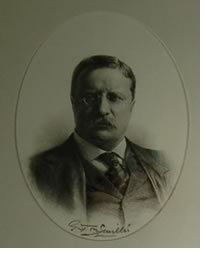 As Brown
and Gilbert talked with President Roosevelt, Roosevelt began to
talk about leaving a “legacy” to the AIA. The idea was
never fully defined, but a letter from the White House, signed by
Roosevelt and dated Dec. 19, 1908, arrived at the Octagon on
December 21. The President had evidently kept the letter before him
for a while, making changes in his own hand, before he was
satisfied and sent it. “My dear Mr. Gilbert: Now that I am
about to leave office there is something I should like to say thru
you to the American Institute of Architects. During my incumbency
of the Presidency the White House, under Mr. McKim’s
direction, was restored to the beauty, dignity and simplicity of
its original plan. It is now, without and within, literally the
ideal house for the head of a great democratic republic. It should
be a matter of pride and honorable obligation to the whole Nation
to prevent its being in any way marred. If I had it in my power as
I leave office, I should like to leave as a legacy to you, and to
the American Institute of Architects, the duty of preserving a
perpetual ‘eye of guardianship’ over the White House to
see that it is kept unchanged and unmarred from this time on.
Sincerely yours, [signed] Theodore Roosevelt.
As Brown
and Gilbert talked with President Roosevelt, Roosevelt began to
talk about leaving a “legacy” to the AIA. The idea was
never fully defined, but a letter from the White House, signed by
Roosevelt and dated Dec. 19, 1908, arrived at the Octagon on
December 21. The President had evidently kept the letter before him
for a while, making changes in his own hand, before he was
satisfied and sent it. “My dear Mr. Gilbert: Now that I am
about to leave office there is something I should like to say thru
you to the American Institute of Architects. During my incumbency
of the Presidency the White House, under Mr. McKim’s
direction, was restored to the beauty, dignity and simplicity of
its original plan. It is now, without and within, literally the
ideal house for the head of a great democratic republic. It should
be a matter of pride and honorable obligation to the whole Nation
to prevent its being in any way marred. If I had it in my power as
I leave office, I should like to leave as a legacy to you, and to
the American Institute of Architects, the duty of preserving a
perpetual ‘eye of guardianship’ over the White House to
see that it is kept unchanged and unmarred from this time on.
Sincerely yours, [signed] Theodore Roosevelt.
Gilbert responded “I have no hesitation in assuring you, Mr.
President, that the American Institute of Architects will accept
all the honorable obligation which your letter implies and will
lend its influence always to the preservation of the White House as
it now stands unchanged and unmarred for future generations of the
American people.”
Copyright 2005 The American Institute of Architects. All rights reserved. Home Page

